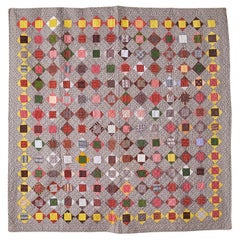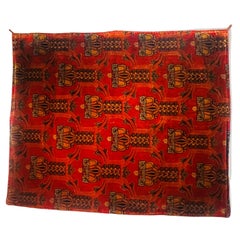American Tapestries
Color: Yellow
Place of Origin: American
Antique Cotton Grey and Yellow “Economy Patch" Quilt, USA, Late 19th Century
Located in Copenhagen K, DK
USA, late 19th Century
“Economy Patch” antique quilt.
H 205 x W 205 cm
Category
Late 19th Century Antique American Tapestries
Materials
Cotton
Related Items
Art Nouveau 19th Century Velvet Wall Hanging
Located in Doha, QA
Magnificent very thick hand-woven velvet wall hanging with unique and typical Art Nouveau design. This beautiful decorative piece of art has a heav...
Category
19th Century Art Nouveau Antique American Tapestries
Materials
Wool, Velvet
Antique 19 Century Suzani Panel Wall Hanging
Located in Delray Beach, FL
Antique Suzani textile made of hand silk embroidery, intricate scrolling vines and flowers motifs on a handwoven cotton background. Professional...
Category
Early 1900s Antique American Tapestries
Materials
Cotton, Silk
Viso Tapestry Cotton Blanket VTB0602 in White and Black
Located in New York, NY
Wøven into German jacquard looms in one hundred percent cotton with our exclusive patterns, each of our tapestries are finished by hand in the united states. The technique used to cr...
Category
2010s American Tapestries
Materials
Tapestry, Cotton
Antique 19th Century Suzani Panel Wall Hanging
Located in Delray Beach, FL
Antique Uzbek wall hanging made of combination of hand embroidery Suzani squares, silk Ikat, antique velvet and other textile all together with decorative Suzani border to become bea...
Category
Early 1900s Antique American Tapestries
Materials
Cotton, Wool, Velvet, Silk
19th Century Uzbek Silk Embroidered Suzani Tapestry
Located in New York, NY
19th century Uzbekistani hand spun linen Suzani with silk embroidered floral motif and silk ikat border. Reverse side has original antique Fine hand printed cotton backing.
Category
19th Century Suzani Antique American Tapestries
Materials
Linen, Silk
Early 19th Century Tashkent Suzani Fragment
Located in London, GB
Charming Suzani fragment from either Tashkent or Pishkent.
Could be mounted onto a fabric covered stretcher or made into cushion covers.
circa 1900
Category
Early 19th Century Suzani Antique American Tapestries
Materials
Cotton, Silk
18th Century Italian Mecca Hand-Carved Tassels on an Antique Braid
By Interi
Located in Dublin, Dalkey
18th century Italian hand-carved mecca tassels strung on an antique braid. The tassels originally came from an Italian church in Tuscany and were used during feast days. The braiding...
Category
18th Century Rococo Antique American Tapestries
Materials
Metal, Silver Leaf
Brocade Silk Bangladeshi Kantha Quilt, Late 20th Century
Located in New York, NY
Bangladeshi quilts, known as Kantha, consist of two to three pieces of cloth sewn together with decorative embroidery stitches. They are made out of Saris and are mainly used for bed...
Category
1980s Agra Vintage American Tapestries
Materials
Canvas, Silk
Americana Crazy Quilt, by Ida Rich Williams, 1906
By Ida Rich Williams
Located in Houston, TX
“American Crazy Quilt” from 1906 we acquired. It literally has history woven into
the fabric of this extraordinary piece. Quilt Artists were infamous for telling the
story of their...
Category
Early 20th Century Schoolhouse American Tapestries
Brussels Late 17th Century Tapestry Asia from a Four Continents Series 9'4 x 18
Located in New York, NY
Brussels late 17th century tapestry, "Asia" from a Four Continents series. Designed by Lodowijk van Schoor, Woven in the Workshop of J. van der Borcht I Size: 9'4 high x 18' wide.
Wool, silk and metal thread pattern wefts
This extremely colorful and attractive late Baroque Flemish tapestry with a popular iconography is the product of two important figures in 17th century Brussels weaving. J. van der Borcht I (circa 1650–1713) was a master weaver and tapestry entrepreneur who established a most distinguished family tapestry firm and was followed by J. van der Borcht II, Jasper van der Borcht, Pieter van der Borcht and Jan Frans van der Borcht, taking the operations into the mid18th century. Their wealthy patrons allowed the firm to engage some of the best designers and as a result the artistic quality, as well as the sheer technical execution, is always high. The Van der Borchts wove tapestry series (or single pieces) of Mythological Scenes, Months, Allegories, Armorials, Triumphs of the Gods, The Continents, as well as more down-to-earth genre scenes designed or inspired by David Teniers II or Teniers III.
Their artist designers included, besides the Teniers, Jan van Orley, Augustin Coppens, Gerard Lairesse, Phillipe de Hondt, and the Antwerp-born Lodowijk van Schoor (circa 1650–1702), the designer of U-1362. Van Schoor was the successor of David Teniers III. He was the designer or co-creator of about fifteen sets of tapestries. His cartoons were utilized and copied in both the Northern and Southern Netherlands, and continued popular well into the 18th century. His style, especially in his later works, is more harmonious and refined than Teniers and he avoided genre scenes with peasants. Van Schoor sometimes collaborated with other artists, for example Lucas Aertschellinck (1620 – 1699) who specialized in landscape backgrounds as in the set of Mythological Scenes” woven circa 1700 in the Van der Borcht shop. He did not collaborate on this tapestry, Van Schoor’s figures are graceful and his color schemes vivid, in keeping with the best of contemporary Flemish tapestry. Van Schoor’s designs influenced artists working at great remove from Brussels, even so far as the Florentine workshop of Bernini and Demignot where a Van Schoor inspired “Four Continents” set was woven in the early 1720s.
The “Four Continents” or “Four Parts of the World” was a popular theme in the 17th and 18th centuries for tapestry patrons. Each continent was identified by native peoples and animals: America (North and South together) by Indians and the Turkey bird...
Category
17th Century Antique American Tapestries
Materials
Wool
H 112 in W 216 in D 0.25 in
140" Paisley 19th c Shawl
Located in Water Mill, NY
A Wonderful Colors 19th Century Paisley Shawl
Category
19th Century Antique American Tapestries
Late 16th Century Audenarde Mythological Tapestry 21'6 x 11'4
Located in Secaucus, NJ
Audenarde mythological tapestry panel Audenarde, southern low countries, measures: 11'4 high x 21'6 wide late 16th century the tapestry has three distinct scenic sections: hunters to...
Category
17th Century Antique American Tapestries
Materials
Wool
Recently Viewed
View AllMore Ways To Browse
Japanese Silk Embroidery Tapestry
Antique Egyptian Wall Hanging
Antique Cross Stitch Sampler
Antique Suzani Wall Hanging
Antique Tapestry Bag
Needle Point Tapestry
Antique Bohemian Tapestry
Antique Needlepoint Picture
Christian Tapestry
Antique French Tapestry Wall Hangings
Berber Bags
Cupid Tapestry
Antique Tapestry Hunt
Hand Stitched Sampler
The Lady And The Unicorn
Silk Wall Hangings
Lady And The Unicorn
Heraldic Tapestry


